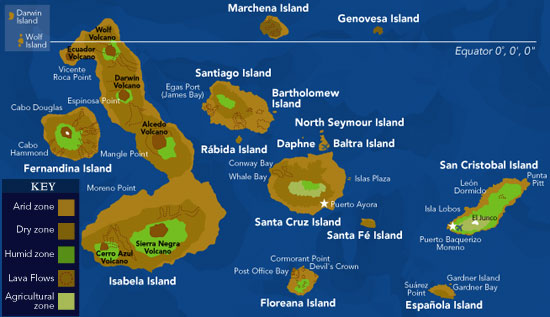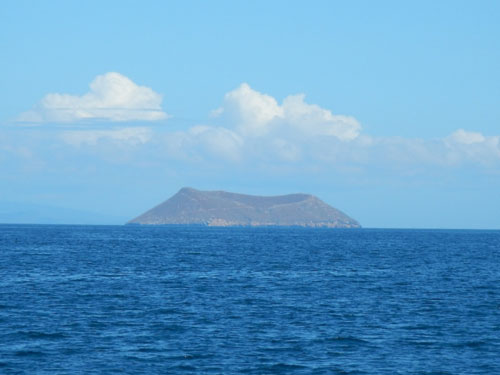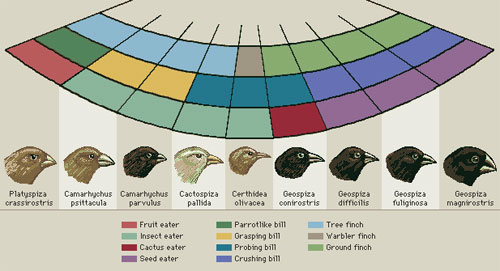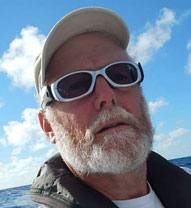 As I write this, I am less than 100 miles from Panama where I will commence a whole new adventure by traversing the Panama Canal.
As I write this, I am less than 100 miles from Panama where I will commence a whole new adventure by traversing the Panama Canal.
I do have a few more observations to share about my time in the Galapagos, but while I write those up, I’d like to hand-off here to our ocean scientist colleague Tegan Mortimer, who will share with us yet another in her wondrous series of “Science Notes” (See them all here!) – this new one on the Galapagos, naturally… as seen through the awesome lens of science! Take it away Tegan!
________________________________________________________________________
:: Tegan’s Science Notes #9 – The Galapagos
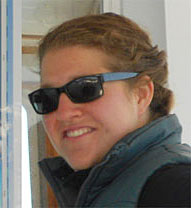 Sailors called them the Enchanted Isles because strong currents and swirling mists could cause the islands to disappear and reappear right before their eyes. The Galápagos were made famous by Charles Darwin’s visit in 1835 during his voyage on board the HMS Beagle. The observations Darwin made on the islands had a direct impact on the development of his theory of evolution. Today these islands are still an unmatched source of biological wonder and continue to contribute to our study and understanding of the process of evolution.
Sailors called them the Enchanted Isles because strong currents and swirling mists could cause the islands to disappear and reappear right before their eyes. The Galápagos were made famous by Charles Darwin’s visit in 1835 during his voyage on board the HMS Beagle. The observations Darwin made on the islands had a direct impact on the development of his theory of evolution. Today these islands are still an unmatched source of biological wonder and continue to contribute to our study and understanding of the process of evolution.
Despite straddling the equator, the Galápagos do not have a tropical feel. In fact this archipelago is home to the northernmost penguin colony in the world, the only native penguins to be found in the Northern Hemisphere (though the penguins do spend most their time in the Southern Hemisphere, as only the most northern island is above the equator). You’ll remember from my African Penguins post (again, they are all listed on the Citizen Science page) that the KEY is in the water: cold, nutrient-rich water.
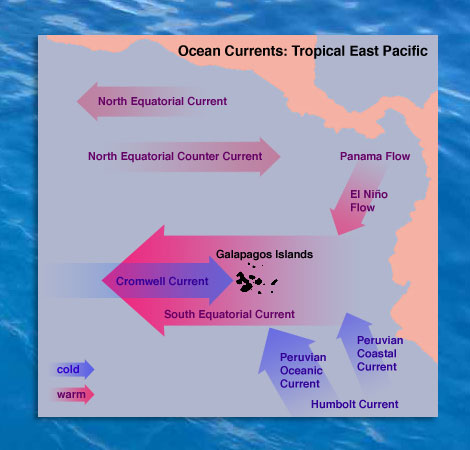
Source: http://cmi2.yale.edu/galapagos_public/data.html
The Galápagos Islands are located in a unique area in which can be found the convergence of several currents of tropical and subtropical waters that upwell around the islands. For a long time oceanographers thought that the cold waters surrounding the Galápagos came from the Humboldt Current (also known as the Peru Coastal Current) which runs along the western coast of South America carrying cold Antarctic water northward. However another type of current, called an undercurrent, which runs below and opposite to a surface current, was discovered in 1956. This current, called the Equatorial Undercurrent or Cromwell Current after its discoverer, is now seen as the reason for the island’s cool waters. The Cromwell Current flows eastward the entire length of the equator in the Pacific Ocean at a depth of about 100 meters below the westward flowing surface currents. As the current approaches the Galápagos, it is forced upwards by underwater seamounts forming an upwelling system. The waters then flow westward again as part of the South Equatorial Current.
There is a reason why Darwin’s visit to the Galápagos (as well as other islands) had such an effect on his ideas about evolution and natural selection. Islands often have a large number of endemic species, i.e., those that are found nowhere else. The Galápagos are no exception to this. But why do islands have so many unique animals? Geologically, the Galápagos are fairly young, they are volcanic islands formed sometime between 80 and 90 million years ago. In that time animals had to colonize the newly formed islands from the closest landmass, which is the mainland of South America, over 500 miles away. Of all the animal colonizers that reached the Galápagos, only a few would be able to survive and establish populations, which are the animals that still survive today – many of which Dave talked about in his updates.
When animals colonize islands, a few things often happen. These animals have been ‘released’ from pressures like competition and predation that they were under in their original locale. so they can quickly diversify to take advantage of the many different ecological niches that are available in their new home. These animals often don’t have to worry about predators any longer so they lose many of their anti-predator behaviors. Dave’s story about the baby sea lion illustrates this very point. The parent seals can leave the babies alone while they go hunting, knowing that no predator will attack the vulnerable babies. It may also help explain why the baby sea lion in Dave’s story came right up to the tour group without any hesitation. Among birds, this absence of predators can account for why birds may become flightless (like the cormorant) or lay their eggs on the ground, just as the blue-footed booby does.
These traits make islands very susceptible to the effects that follow from introducing animals like cats, dogs and rats which can easily prey on native animals. Humans too have had a heavy impact on island populations by hunting some animals to extinction. Luckily, today we have come to realize just how fragile these ecosystems are, which has caused many people and organizations to take up the work of protecting such special and “endangered” places… including the Galápagos.
Darwin’s Finches
There’s one group of animals from the Galápagos that needs a special mention. Darwin’s finches are a group of 15 species of birds found throughout the islands which Darwin specifically mentions in his Origin of Species. In this way, these birds became an important part of the scientific history of evolutionary thought, and as I will explain still maintain an important role in our modern understanding of evolution and the ways humans can impact it.
These birds are the classic example the adaptive radiation I mentioned earlier. A colonizer species to the island, the finches diversified into these 15 species all of which have different shaped beaks, each of which is related to what type of food that particular species eats. These birds are thought to be the fastest evolving animals on earth, which means that researchers can follow them, year to year, and track the natural selection pressures which define which species thrive and which do not.
However, another pressure is being placed on them as well. Human foods, like rice, are now widely available in much of these finches’ range. Birds that feed on human foods can lose the characteristics that make them evolutionary ‘fit,’ as earlier selection pressures are no longer being placed on them. The loss of these characteristics can erode the differences between the various species of finches leading to a loss of biodiversity. So instead of 15 different species, which are highly evolved to eat different food sources, it’s possible we may end up with just a few species that feed on human scraps. It would be tragic loss of such an amazing group of birds.
This study of the finches is actually a research project that my colleagues at Earthwatch are conducting in the Galapagos not far from where Dave moored Bodacious Dream. You can find out more about their project called Following Darwin’s Finches in the Galapagos at the link.
– Tegan
:: For more exciting science insights and opportunities, please check out our BDX Explorer Guides or stop by our Citizen Science Resources page, where you can also find all of Tegan’s previous Science Notes, Also, we welcome your input or participation to our BDX Learning and Discovery efforts. You can always reach us at … <oceanexplorer@bodaciousdreamexpeditions.com>
:: BDX Website :: Email List Sign-Up :: Explorer Guides :: BDX Facebook

